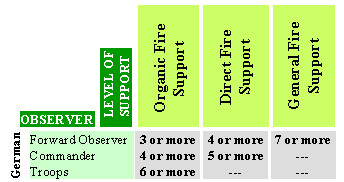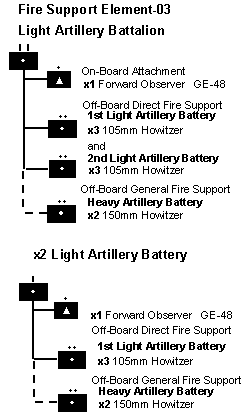Battlefront WWII
German Artillery
German Artillery
Next Tutorial (Russian Artillery Doctrine)
Previous Tutorial (Scenario Artillery)
Tutorial Table of Contents
| Introduction to German Artillery | Using German Artillery in BF | Fire Plans | Other Nations using German Methods |
German Artillery
Table of ContentsAt the end of World War I, the German military was forcibly dismantled by the Treaty of Versailles. Long-range and heavy artillery was destroyed and the largest artillery piece was limited to the 105mm Field Howitzer. Whereas the emphasis in the final years of WWI had been on centralized control of massed firepower, in the 1920's more weight was put on individual artillery batteries and the authority of the individual battery commander. After Hitler repudiated the Treaty of Versailles, heavy artillery reappeared in the inventory, and Bruchmüller's theories were reintroduced. However, the emphasis on battery control was never completely erased. Also, the Field Artillery was definitely a forgotten stepchild when it came to equipment, the Luftwaffe and Panzer forces being favored for modernization, especially in communications equipment. The result was that the Germans entered the war with a system that was little advanced from what was used in World War I, with radios supplementing field telephones. It could be responsive and highly accurate at the battery level, but had little or no capability of massing fires, especially over short periods of time. German artillery also suffered from a general lack of equipment, which was offset somewhat by the use of heavy mortars and rocket launchers.
The German emphasis was on "destruction of point targets". With true Germanic :-) precision, they would do the calculations intended to drop the initial rounds on top of the intended target. This requires accurate range estimation and incorporation of lots of correction factors for weather conditions, relative heights of the battery and target, barrel wear, etc. In his lecture, David Weseley says that when engaging targets of opportunity, they retained a relative inefficient method of computing range and direction that required them to know the relative range and bearing of the target, observer, and battery instead of the methods used by the British and U.S., who needed only the map positions of the target and battery. His point is that these calculations took time, and the average response time from call-for-fire to mission was on the order of 10-12 minutes. Whether this technique improved during the war is debatable, and unfortunately most sources tend to discuss German equipment rather than doctrine. On defence or for deliberate attack, the emphasis on precision was not a problem, as the German observers and survey parties would do the calculations for lots of potential fires. A concentration could then be brought down by means of a code word and a map reference. The artillerymen of Grossdeutschland summed up their defensive technique as "many tubes, few rounds, suddenly, on a single point." and it often slowed up or stopped a Soviet breakthrough.
The Germans liked to fire by battalion, but the batteries could split up to support individual infantry battalions, providing a small volume of relatively responsive fire, especially when the infantry battalion had a separate mission. They would then reform when the battle was concluded. On defence, or in a deliberate attack, the Germans were well drilled on combining the fire of multiple batteries and even battalions. At higher levels of command, the Germans retained great administrative flexibility. They would parcel out artillery from the army reserve into task-oriented forces and reorganize artillery as needed and they still retained the ability to do Bruchmüller-style artillery fire plans. However, this flexibility will generally not be seen in a Battlefront game, because it was part of the preparation for the battle instead of the execution of the battle. They also made one attempt to reorganize their artillery based on a coherent divisional organization, but this was submerged in the Russian flood. Also, as German artillery remained numerically weak throughout the war, and gathering large artillery formations at one point would require stripping other areas of the front of some of their support.
Finally, much of the German artillery (and indeed much of their army), relied on horse-drawn transport. Reducing their pace to that of the horse and meant that they took longer to get into position. As Battlefront games generally begin with forces in place, this will not usually effect things.
German Artillery can be classified:
- Command - Medium-High level. While the Germans often permanently assigned batteries and battalions to support specific units, they kept some of their artillery in reserve and parceled it out to the areas of the front where it was needed. While they were capable of using coordinated strikes in a prepared fireplan, they didn't do this well against targets of opportunity.
- Control - Medium. Forward observers and officers made most of the calls-for-fire for the artillery. They were generally tied to controlling specific elements.
- Communications - Average. Radios were not as prevalent as might be expected for a modern army. Ground-lines were used heavily. When they did use radios, they were used to connect the observer to the individual elements that were under his control. Unlike the British and Americans, the Germans did not fully develop the concept of a radio net that allows the rapid sharing of resources. In Battlefront, this means that the Germans do not have any special multiple-element missions.
Using German Artillery in Battlefront
Table of Contents- German Forward Observers should be associated with a specific Fire Support Element and should not be able to request fire for other elements.
- The Germans should have no special multi-battalion missions. The Germans should perform no thickening missions outside of their battalion organization.
- You can provide multiple FOs for a battalion, but only one can call-for-fire from the battalion on any one turn. If they break up into battery fire, each FO should be assigned to a specific battery.
- If the Germans are attacking, you can allow them can break up their artillery battalions into batteries (as per the FS-03 to the right), once the batteries are broken down, they generally will lose the ability to recombine into a battalion mission within the scope of the game. You can also specify that the artillery will fire as a battalion for the duration of the game and not allow breakdown. Note that if the battalion fires a 1-battery shelling mission (as per the restriction on p.39), this does NOT constitute a breakdown into batteries. This restriction should not apply when the Germans are on defence, where they should be allowed to fire individual battery missions and then recombine.
- The Germans should generally be limited to a single GS battery in a battalion (as in FS-03). If the battalion splits into batteries, the GS battery must go with a specific DS battery and FO and not be used with any other.


Fire Plans
Table of Contents
You can give the Germans flexibility in assigning pre-game fire plans. Also, when defending, be sure to give the German some preregistered points as part of a defensive fire plan.
You can give the Germans flexibility in assigning pre-game fire plans. Also, when defending, be sure to give the German some preregistered points as part of a defensive fire plan.
Other Countries
Table of Contents
The German methods were quite similar to those in use in WWI, and it is reasonable to use them for Axis minor countries such as the Romanians and Hungarians, and other minor combatants whose methods are unknown. French methods were also, popular, especially in Western Europe.
The German methods were quite similar to those in use in WWI, and it is reasonable to use them for Axis minor countries such as the Romanians and Hungarians, and other minor combatants whose methods are unknown. French methods were also, popular, especially in Western Europe.